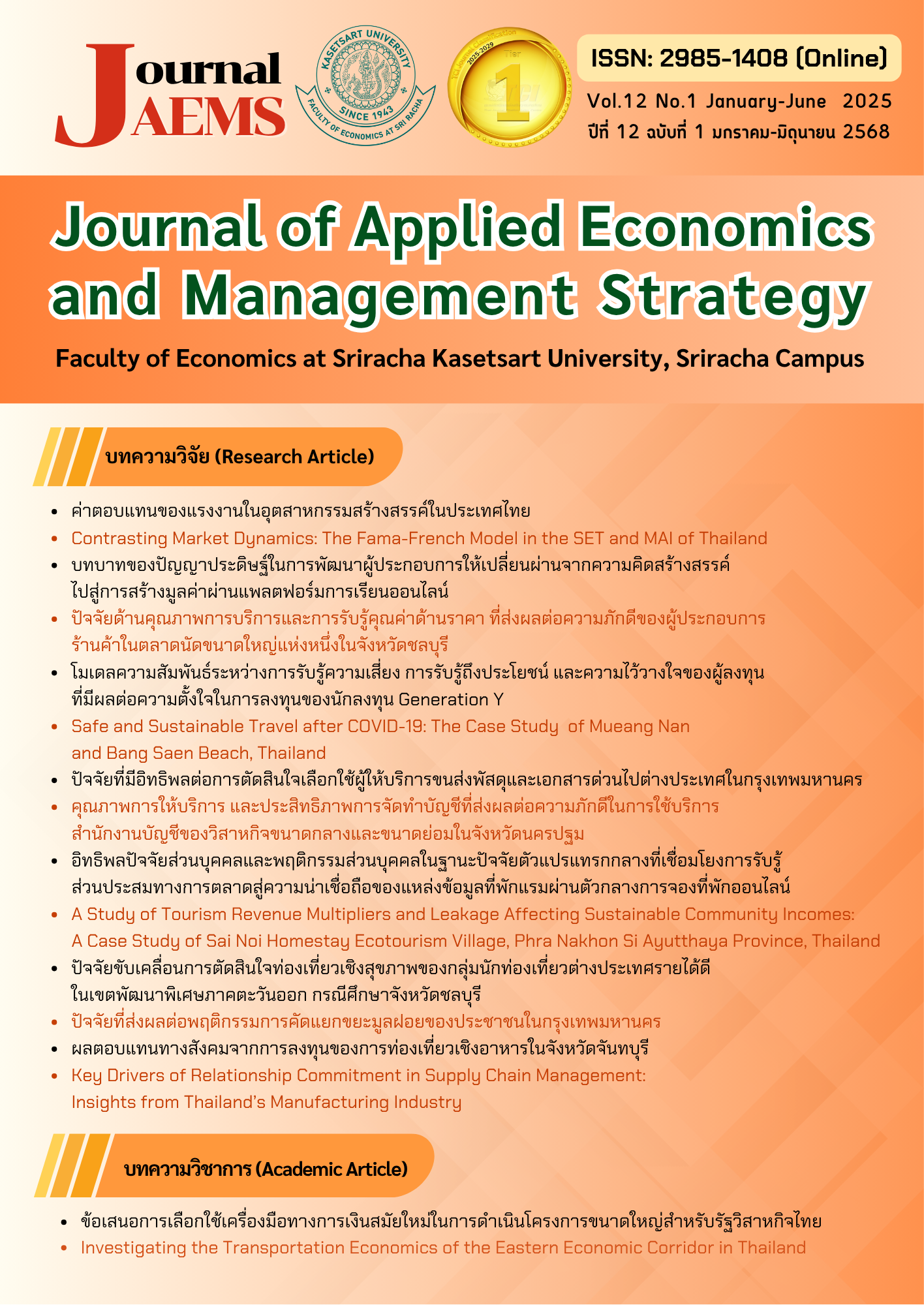Safe and Sustainable Travel after COVID-19: The Case Study of Mueang Nan and Bang Saen Beach, Thailand
Main Article Content
Abstract
This study employs the open-ended Contingent Valuation Method (CVM) to assess willingness to pay (WTP) for a travel safety zone in Nan Old Town and Bang Saen Beach, Thailand, selected by the Department of Tourism, the Ministry of Tourism and Sport. The study consists of 406 samples using the convenience sampling method. Results reveal an average WTP of 200 baht (approximately 6 U.S. dollars), influenced by income, education, and travel expenses. The hypothetical aggregate WTP supports the potential extension of the program to other sites in Thailand. Despite the absence of entry fees, the program's private benefits surpass its costs, with an aggregate WTP of 79 million baht compared to program costs of 15 million baht. The study suggests a favorable scenario for governmental investment in social benefits. Enhanced site quality and safety promises increased visitation, aiding sustainable tourism development. The program, crucial during crises like COVID-19, should remain adaptable for future challenges, fostering resilience through partnerships and community involvement. Promoting capacity building and operational sustainability aids long-term risk management in the tourism sector.
Downloads
Article Details

This work is licensed under a Creative Commons Attribution-NonCommercial-NoDerivatives 4.0 International License.
References
Arrow, K., Solow, R., Portney, P. R., Leamer, E. E., Radner, R., & Schuman, H. (1993). Report of the NOAA panel on contingent valuation. Federal Register, 58(10), 4601–4614.
Asafu-Adjaye, J., & Tapsuwan, S. (2008). A contingent valuation study of scuba diving benefits: Case study in Mu Ko Similan Marine National Park, Thailand. Tourism Management, 29(6), 1122–1130.
Báez-Montenegro, A., Echeverría, R., Sepúlveda, E., & Calcagni, V. (2022). Does an environmental disaster influence the tourists’ willingness to pay for a wetland? the case of the Cruces River Wetland in Southern Chile. Wetlands, 42(7), 82.
Bhandari, A. K., & Heshmati, A. (2010). Willingness to pay for biodiversity conservation. Journal of Travel & Tourism Marketing, 27(6), 612-623.
Dribek, A., & Voltaire, L. (2017). Contingent valuation analysis of willingness to pay for beach erosion control through the stabiplage technique: A study in Djerba (Tunisia). Marine Policy, 86, 17–23.
Five attractions named Safety Zone in new tourism campaign. (2021). National News Bureau of Thailand (NNT). Retrieved from https://thainews.prd.go.th/en/news/detail/TCATG210324211519818
Horiuchi, A. (2020). Analyses of entrance fees on waste problem in Koh Larn, Thailand. (Master’s Thesis). The University of Tokyo, Department of International Studies, Graduate School of Frontier Sciences.
Hu, C., Wright, A. L., & He, S. (2022). Public Perception and Willingness to Pay for Urban Wetland Ecosystem Services: Evidence from China. Wetlands, 42(2), 19. https://doi.org/10.1007/s13157-022-01538-6
Impact Assessment of the COVID-19 Outbreak on International Tourism. (2023). World Tourism Organization. Retrieved from https://www.unwto.org/impact-assessment-of-the-covid-19-outbreak-on-international-tourism
International tourism, number of arrivals-Thailand. (2023). World Bank Open Data. Retrieved from https://data.worldbank.org
Isangkura, A. (1998). Environmental Valuation: An Entrance Fee System for National Parks in Thailand. EEPSEA Research Report, Article rr1998091. Retrieved from https://ideas.repec.org//p/eep/report/rr1998091.html
Lakkhanaadisorn, W. (2014). The Valuation of Heritage Interpretation for Conservation and Sustainable Tourism: A Case Study of the Historic City of Ayutthaya. NIDA Development Journal, 54(2), 85–116.
Lamsal, P., Atreya, K., Pant, K. P., & Kumar, L. (2016). Tourism and wetland conservation: Application of travel cost and willingness to pay an entry fee at Ghodaghodi Lake Complex, Nepal. Natural Resources Forum, 40(1–2), 51–61.
Lekagul, A. (2018). Differences in Patterns and Factors Influencing Preference and Willingness to Pay for Physical Developments of a Streetscape in the Old Town of Chiang Mai, Thailand. Nakhara: Journal of Environmental Design and Planning, 14, 79–94.
Parsons, G. R. (2017). Travel cost models. A Primer on Non-market Valuation, 187–233.
Rogers, A. A., Dempster, F. L., Hawkins, J. I., Johnston, R. J., Boxall, P. C., Rolfe, J., Kragt, M. E., Burton, M. P., & Pannell, D. J. (2019). Valuing non-market economic impacts from natural hazards. Springer.
Saengsupavanich, C., Seenprachawong, U., Gallardo, W. G., & Shivakoti, G. P. (2008). Port-induced erosion prediction and valuation of a local recreational beach. Ecological Economics, 67(1), 93–103.
Sakonnakon, S. P. N., Hirunsalee, S., Kanegae, H., & Denpaiboon, C. (2012). Donations for Cultural Heritage Protection against Floods: A Case Study of Ayutthaya World Heritage, Thailand. Disaster Mitigation of Cultural Heritage and Historic Cities, 6, 215–222.
Sanyakamdhorn, P. (2017). Valuing cultural heritage: A contingent valuation study of temples in Chiang Saen.
Thailand Tourism Statistics. (2023). Ministry of Tourism & Sports. Retrieved from https://www.mots.go.th/news/category/411
Travel & Tourism Economic Impact. (2023). World Travel & Tourism Council (WTTC). Retrieved from https://wttc.org/research/economic-impact
Wang, P.-W., & Jia, J.-B. (2012). Tourists’ willingness to pay for biodiversity conservation and environment protection, Dalai Lake protected area: Implications for entrance fee and sustainable management. Ocean & Coastal Management, 62, 24–33.
